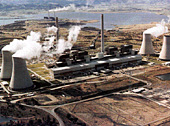![]()
![]()
![]()
![]() What
is Equity?
What
is Equity?
![]() Equity
Within Nations
Equity
Within Nations
![]() Equity
Between Nations
Equity
Between Nations
![]() International
Economic System
International
Economic System
![]()
![]()
![]() Global
Warming and Equity
Global
Warming and Equity
![]() Impacts
Impacts
![]() •
Responsibility
•
Responsibility
![]() Actions
Actions
![]() Australia
Australia
![]()
![]()
![]() References
References
![]() Site
Map
Site
Map
![]()
|
Responsibility for Global Warming is not shared by all nations equally |
It has generally been recognised that the industrialised and high-income nations have been the main sources of greenhouse gases. Carbon is one of the largest waste products of modern industrial civilisation; 3.7 tonnes of carbon dioxide is added to the greenhouse gases for each tonne of carbon emitted into the air (Flavin 1990). Industrialised capitalist nations, have contributed a large proportion of the carbon emissions from fossil fuels.
Carbon dioxide accounts for about 55 per cent of the current contribution to the greenhouse effect and has an average lifetime of one hundred years. Chlorofluorocarbons account for another 24 per cent of the greenhouse effect, last for about one hundred years and are also mainly emitted by the industrialised nations. Other greenhouse gases include methane (15 per cent, lifetime ten years) and nitrous oxide (6 per cent, lifetime 200 years).
Most of the greenhouse emissions from low-income countries come from deforestation; almost all of the carbon released from tropical rainforests comes from clearing in low-income countries. However, this clearing has been accelerated by the international monetary system and the debt that these countries are facing. An example of this can be seen in Brazil, which contributes 20 per cent of the world's carbon emissions from deforestation. Brazil's debt is the largest in Latin America and amounts to more than $US115 billion. It is paying interest at the rate of billions of dollars per year.
Loan money from the World Bank has been used for large power projects such as the $8 billion Tucurui Dam, which required the destruction of 216 000 hectares of forest and the displacement of thirty thousand people. Jim Falk and Andrew Brownlow (1989, p. 180) have described how the combination of debt repayments, the resulting need for export earnings, and also World Bank loans, encourage deforestation:
"World Bank loans go to supporting the large land-owners to maintain huge estates in the north-east whilst cash crops are planted for export in the south. So thousands of peasants pour into Amazonian Rondonia because they have been dispossessed from land in the south now being planted with cash crops. Their only hope is to clear forest. So in the north they clear the forest to provide themselves with land for grazing and cropping. Deprived of its tree cover the cleared land is quickly leached of nutrients, requiring them to clear further land to provide a good crop."
Use of fossil fuels and therefore carbon dioxide emissions from fossil fuels in low-income countries has remained low because of the poverty that accompanies the debt burden. If it were not for this poverty, these nations would be developing and their use of fossil fuels would be expanding, as has happened in South Korea. Were such countries to overcome their economic problems, fossil fuel use could soar.
Vandana Shiva (1990, pp. 6&endash;7) argues that the reason for this is that western models of development have been forced onto low-income countries, ensuring that development contributes to the greenhouse effect. 'The tractor and automobile as a symbol of progress, and the plough and bullock cart as a symbol of backwardness was part of the cultural transformation associated with development.' This type of development, towards a more wasteful use of energy, resulted from cultural and economic colonisation and the fact that aid and loans ensured western technology would be used, thus sending the money back to the countries of origin.
Even if low-income nations do not increase their standards of living but merely continue to expand their populations at current rates, this will also lead to increasing carbon dioxide emissions.
Source: Sharon Beder, The Nature of Sustainable Development, 2nd edition, Scribe, Newham, Vic.,1996.
![]()
 Responsibility
Responsibility